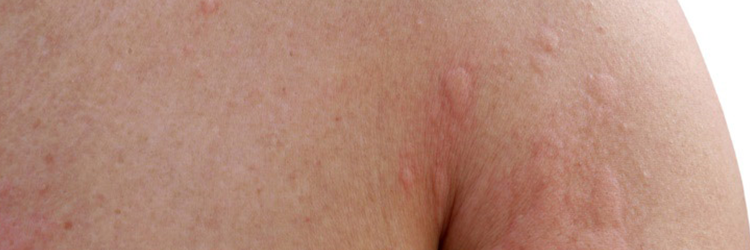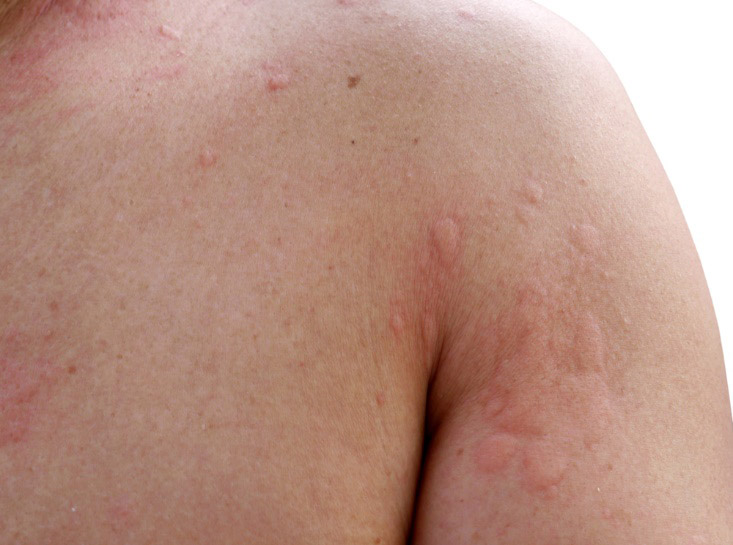Hives (medically known as Urticaria) usually appears as a mild to severe itchy patch on skin, which turns into swollen red welts or red raised marks or scars. Generally caused due to an allergic reaction to certain foods, drugs or infections, it is found to affect 20 percent of people at some point of time in their lives.
The size of hives may vary from a pen tip to a dinner plate. Generally, hives disappear in 24 hours or less. However it may last longer as new hives may appear after old ones fade. Hives that last for 6 weeks are called chronic hives.
-
-
Symptoms
-
Hives can be characterized by raised itchy red or skin coloured bumps, which when pressed at the centre may turn white.
-
-
Triggers
-
Foods including peanuts, eggs, nuts and shellfish and medications such as antibiotics (especially penicillin and sulpha drugs), aspirin and ibuprofen have been identified as the major triggers for hives. In addition, insect stings or bites, latex, blood transfusions, physical stimuli including pressure, cold, heat, exercise or sun exposure, and bacterial infections (especially urinary tract infections and strep throat) and viral infections (common cold, infectious mononucleosis and hepatitis) can also flare up hives.
-
-
Treating Urticaria
-
In most cases, hives don’t need treatment, especially if symptoms are mild. However, your dermatologist may prescribe treatment in other cases.
-
-
Short-term Urticaria
-
In case of troublesome or persistent symptoms, antihistamine medication may be used. It is available over-the-counter at pharmacies. However it is advised to consult a dermatologist before using any medication.
For severe symptoms, your doctor may prescribe short course of high-dose corticosteroid tablets, such as prednisolone. Corticosteroids reduce the symptoms by suppressing the immune system. Doctors usually don’t prescribe steroid tablets for a long duration as these can cause side effects including glaucoma, cataracts, diabetes and high blood pressure; report to your doctor if symptoms don’t subside within two weeks.
Your GP can also prescribe antihistamines to block the effects of histamine and help relieve itchiness and rash. Inform your doctor if you are pregnant as antihistamines are usually not prescribed during pregnancy.
-
-
Long-term Urticaria
-
Treatment for persistent or long-term Urticaria involves symptom-control and trigger-avoidance. Chronic Urticaria and Angioedema (swelling of a deeper layer of skin) should be referred to an expert.
Antihistamines are used to treat chronic Urticaria. Your doctor may also recommend a combination of antihistamines to help you fall sleep.
Dosage may be increased if the initial symptoms are not relieved. However, expert supervision is required to administer the increased dosage.
-
-
- Menthol cream: Menthol cream can be recommended both in addition to and as an alternative to antihistamines. It is used to alleviate itching.
- Corticosteroid tablets: In more serious cases, short doses of corticosteroid tablets, such as prednisolone can be prescribed to relieve symptoms. However, it’s important to watch out for possible side effects including weight gain, increased appetite, mood change and insomnia.
Corticosteroids are not recommended for the long term considering possible side effects. - Other treatment options for long term Urticaria
Narrowband ultraviolet B phototherapy (NUCB): In NUCB, the skin is exposed to ultraviolet light that can help remove the persistent rash. It’s relatively a new treatment option, so there is little evidence to establish its safety. However exposure to UV rays carries a theoretical risk of skin cancer. - Leukotriene receptor antagonists: This type of medication is used to reduce swelling and redness of skin. Researchers recommend this treatment as an alternative to corticosteroid tablets due to lesser known side effects.
- Cyclosporin: Cyclosporin has proved effective in treating Urticaria. Like corticosteroids, it also helps suppress the immune system. Side effects may include high blood pressure, increased levels of blood cholesterol, kidney problems, headaches and involuntary shaking (tremors).
-
Preventive Treatment
-
Though researchers are unsure about the role of diet as a causative factor in long-term Urticaria, two groups of chemicals in foods are known to trigger Urticaria in some people: vasoactive amines and salicylates.
Vasoactive amines are present in foods including strawberries, tomatoes, fish, chocolate and pineapple. Salicylates are found in foods such as tomatoes, spices, orange juice, raspberries and tea.
Avoiding or reducing the consumption of these foods may help improve the symptoms of Urticaria.
It is also advised to avoid taking hot baths or showers and wearing tight-fitting clothing as it can irritate the area and result in a flare-up of symptoms. Last but not the least, don’t self-medicate as it can worsen the symptoms. Report any skin problem to a dermatologist for the right diagnosis.
















